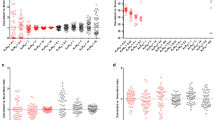Abstract
The inhibitory capacity of a competitive antagonist is measured using the pA2 (the negative logarithm of the antagonist dissociation constant). The conventional two-step procedure, based on Schild’s regression, neglects a portion of the errors. New single step methods are proposed based on nonlinear regression on dose-effect. Whereas verification of the competition hypothesis often interferes with pA2 estimation, the development of improved nonlinear models could explain and partially incorporate the reasons for noncompetition. The improvements are of two kinds: 1. Pharmacological, based on the inclusion of suspected pharmacological mechanisms such as spare receptors or transduction into a nonlinear fixed-effects model (with examples from the literature); and 2. Experimental, incorporating biovariability as a random effect into a mixed-effects model.
Similar content being viewed by others
References
Schild HO. pA, a new scale for the measurement of drug antagonism. Br J Pharmacol. 1947;2:189–206.
MacKay D. How should values of pA2 and affinity constants for pharmacological competitive antagonists be estimated? J Pharm Pharmacol. 1978;30:312–313.
Jenkinson DH, Barnard EA, Hoyer D, Humphrey PPA, Leff P, Shankley NP. International Union of Pharmacology Committee on Receptor Nomenclature and Drug Classification. IX. Recommendations on terms and symbols in quantitative pharmacology. Pharmacol Rev. 1995;47(2):255–266.
Tallarida JR, Cowan A, Adler MW. pA2 and receptor differenciation: a statistical analysis of competitive antagonism. Life Sci. 1979;25:637–654.
Carter EM, Hubert JJ. A growth-curve model approach to multivariate quantal bioassay. Biometrics. 1984;40:699–706.
Ariëns EJ. ed. Molecular Pharmacology: The Mode of Action of Biologically Active Compounds. Vol 1. New York and London: Academic Press; 1964.
Waud DR, Parker RB. Pharmacological estimation of drug-receptor dissociation constants. Statistical evaluation. II. Competitive antagonists. J Pharmacol Exp Ther. 1971;177(1):13–24.
Stephenson RP. A modification of receptor theory. Br J Pharmacol. 1956;178:379–393.
Black JW, Leff P. Operational models of pharmacological agonism. Proc R Soc Lond. 1983; B220:141–162.
Grizzle JE, Allen DM. Analysis of growth and dose response curves. Biometrics. 1969;25:357–381.
Volund A. Multivariate bioassay. Biometrics. 1980;36:225–236.
Laird NM, Ware JH. Random-effects models for longitudinal data. Biometrics. 1982;38:963–974.
Jennrich RI, Schluchter MD. Unbalanced repeated-measures models with structured covariance matrices. Biometrics. 1986;42:805–820.
Vonesh EF, Carter RL. Efficient inference for random-coefficient growth curve models with unbalanced data. Biometrics. 1987;43:617–628.
Elston RC, Grizzle JE. Estimation of time-response curves and their confidence bands. Biometrics. 1962;20:148–159.
Lindstrom MJ, Bates DM. Nonlinear mixed effects models for repeated measures data. Biometrics. 1990;46:673–687.
Sheiner LB, Beal SL. Evaluation of methods for estimating population pharmacokinetic parameters. J Pharmacokinet Biopharm. 1980;8:553–571.
Vonesh EF, Carter RL. Mixed-effects nonlinear regression for unbalanced repeated mesures. Biometrics. 1992;48:1–17.
Laird NM, Lange N, Stram D. Maximum likelihood computations with repeated measures: application to the E. algorithm. J Am Stat Assoc. 1987; 82:97–105.
Lindstrom MJ, Bates DM. Newton-Raphson and E. algorithm for linear mixed-effects models for repeated measures data. J Am Stat Assoc. 1987;82:97–105.
Davidian M, Giltninan DM. Some general estimation methods for nonlinear mixed-effects models. J Biopharm Stat. 1993;3:23–55.
Schluchter MD. Analysis of incomplete multivariate data using linear models with structured covariance matrices. Stat Med. 1988;7:317–324.
Author information
Authors and Affiliations
Additional information
Based on a presentation made at the DIA Workshop “Statistical Methodology in Non-clinical and Toxicological Studies,” March 25–27, 1996, Bruges, Belgium. The article presented was called “The pA2 in pharmacology: a need for a new way of estimation.”
Rights and permissions
About this article
Cite this article
Maïofiss, L., Thomas-Haimez, C. & Maccario, J. Competitive Antagonism in Pharmacology: A Proposed Single Step Evaluation. Ther Innov Regul Sci 31, 563–572 (1997). https://doi.org/10.1177/009286159703100224
Published:
Issue Date:
DOI: https://doi.org/10.1177/009286159703100224




